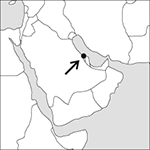
Capital:
Manama
Area:
760 sq km (293 sq miles)
Population:
1,281,332 (2012 est)
Currency:
1 Bahrain dinar = 1000 fils
Religions:
Muslim 81.2%; Christian 9.0%
Ethnic Groups:
Bahraini Arab 46.0%; Iranian, Indian, Pakistani, other Arab, European minorities
Languages:
Arabic (official) and minority languages
International Organizations:
UN; Arab League; OAPEC; GCC; Non-Aligned Movement; WTO
A sheikhdom in the Arabian Gulf.
Physical
Bahrain consists of a group of islands some 32 km (20 miles) off the Arabian coast. The largest island is some 16 km (10 miles) wide and three times as long.
Economy
The country’s exports are dominated by crude oil and petroleum products from a large oil refinery on Bahrain Island. There is also a large financial and business sector, and tourism, shipbuilding, and ship repair are also significant.
History
Iran, which ruled Bahrain from 1602 to 1783, was expelled by the al-Khalifas, who still reign. British political control dates from 1820. Oil was discovered in 1932, when the Bahrain National Oil Company was formed. After the withdrawal of Britain in 1971 and the abandonment by Iran of its claims, the country joined the Arab League. Tension between Shiite and Sunni communities increased, leading to the suspension of the National Assembly in 1975. Together with other members of the Gulf Cooperation Council (Saudi Arabia, Kuwait, Qatar, and Oman), Bahrain repeatedly called for an end to the Iran–Iraq war (1980–88), while retaining its neutrality then and in the Gulf war (1991). Its economy became increasingly diversified as oil reserves dwindled. Increasing opposition to the government and demands for the restoration of the National Assembly led to rising civil unrest in the mid‐1990s. A new constitution was adopted in 2002 and Bahrain became a democratic constitutional monarchy. In 2011 demonstrations inspired by the Arab Spring were violently crushed.
- intergranular
- intergranular displacement
- intergranular pores
- interhalogen
- interim dividend
- interim report
- inter-industry trade
- interior angle(of a polygon)
- interior angle(with respect to a transversal of a pair of lines)
- Interior Earth Object
- Interior Exploration using Seismic Investigations, Geodesy and Heat Transport
- Interior Gateway Protocol
- interior node
- interior(of a curve)
- interior of a set
- interior orientation parameters
- interior path length((of a tree))
- interior point
- interior solution
- interkinesis
- Interkosmos
- interlaced GIF
- interlaced image
- interlaced scanning
- interlacing